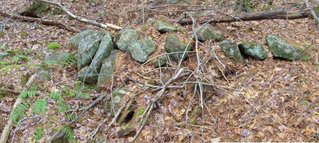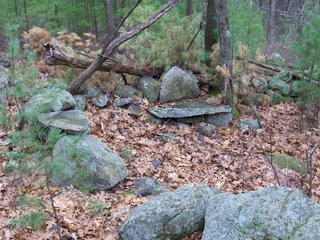First sign that we are nearing something (coming in the way I did) is a couple of overgrown ground piles and a rock on rock.

 As you proceed in a northerly sort of direction, staying to the right of the main outcrops, you get into an area with more of these larger piles.
As you proceed in a northerly sort of direction, staying to the right of the main outcrops, you get into an area with more of these larger piles.
 I am struck by the shape of the top rock in this last picture and comparing it to the top rock of the overgrown pile shown in the second picture above. This kind of looks deliberate and kind of looks like "marker" piles. Here follows another nice substantial pile and then a picture of a pile incorporated into the mearest hint of an alignment:
I am struck by the shape of the top rock in this last picture and comparing it to the top rock of the overgrown pile shown in the second picture above. This kind of looks deliberate and kind of looks like "marker" piles. Here follows another nice substantial pile and then a picture of a pile incorporated into the mearest hint of an alignment:
 At the center of all this was a noticeable boulder configuration. Also pictured is a rock wedged with something that looks red and burnt used for the wedge.
At the center of all this was a noticeable boulder configuration. Also pictured is a rock wedged with something that looks red and burnt used for the wedge.
 After I swung back uphill and over and down into a gully, following the yellow-spot trail over the brook, and a few moments later there is one pile over in there:
After I swung back uphill and over and down into a gully, following the yellow-spot trail over the brook, and a few moments later there is one pile over in there: And on the way back, on the initial side of the brook, is a lime quarry cutting a deep trench through the woods.
And on the way back, on the initial side of the brook, is a lime quarry cutting a deep trench through the woods.





























